Drug Developability: The Derisker

Drug development necessitates a critical balance between the theoretical ideal drug and the practical realities of its creation. This process confronts numerous challenges, with a high risk of failure during the early stages, often referred to as the "valley of death."
To mitigate these risks, a comprehensive understanding of a candidate drug's "developability" is paramount. Developability bridges the gap between the ideal and the real by focusing on two fundamental questions: manufacturability and functionality.
Manufacturability assesses the feasibility of producing the drug in a stable form, at an appropriate scale, and within a cost-effective and timely manner, ensuring sufficient quantities for patient treatment.
Functionality evaluates the drug's mechanism of action, efficacy, and safety profile within the target patient population.
By prioritizing developability early in development, researchers can proactively identify and manage potential roadblocks, thereby minimizing significant cost, quality, and time delays that might arise during later stages of production and clinical trials.
The simple yet effective approach of "Can we make it?" and "Does it work?" empowers researchers to streamline the selection process from a vast pool of potential candidates down to a manageable number. Through continuous refinement of selection criteria and risk mitigation strategies, this approach paves the way towards the realization of the ideal drug. Review the developability steps to success and explore how both pre-defined and tailored work packages can best fit your project needs.
Get unlimited access to:
Enter your credentials below to log in. Not yet a member of Bioprocess Online? Subscribe today.
